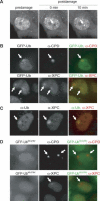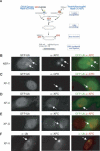DNA damage triggers nucleotide excision repair-dependent monoubiquitylation of histone H2A
- PMID: 16702407
- PMCID: PMC1472908
- DOI: 10.1101/gad.373706
DNA damage triggers nucleotide excision repair-dependent monoubiquitylation of histone H2A
Abstract
Chromatin changes within the context of DNA repair remain largely obscure. Here we show that DNA damage induces monoubiquitylation of histone H2A in the vicinity of DNA lesions. Ultraviolet (UV)-induced monoubiquitylation of H2A is dependent on functional nucleotide excision repair and occurs after incision of the damaged strand. The ubiquitin ligase Ring2 is required for the DNA damage-induced H2A ubiquitylation. UV-induced ubiquitylation of H2A is dependent on the DNA damage signaling kinase ATR (ATM- and Rad3-related) but not the related kinase ATM (ataxia telangiectasia-mutated). Although the response coincides with phosphorylation of variant histone H2AX, H2AX was not required for H2A ubiquitylation. Together our data show that monoubiquitylation of H2A forms part of the cellular response to UV damage and suggest a role of this modification in DNA repair-induced chromatin remodeling.
Figures







References
-
- Araki M., Masutani C., Takemura M., Uchida A., Sugasawa K., Kondoh J., Ohkuma Y., Hanaoka F. Centrosome protein centrin 2/caltractin 1 is part of the xeroderma pigmentosum group C complex that initiates global genome nucleotide excision repair. J. Biol. Chem. 2001;276:18665–18672. - PubMed
-
- Brummelkamp T.R., Bernards R., Agami R. A system for stable expression of short interfering RNAs in mammalian cells. Science. 2002;296:550–553. - PubMed
-
- Citterio E., Vermeulen W., Hoeijmakers J.H. Transcriptional healing. Cell. 2000;101:447–450. - PubMed
-
- Cleaver J.E. Cancer in xeroderma pigmentosum and related disorders of DNA repair. Nat. Rev. Cancer. 2005;5:564–573. - PubMed
Publication types
MeSH terms
Substances
LinkOut - more resources
Full Text Sources
Other Literature Sources
Molecular Biology Databases
Research Materials
Miscellaneous
